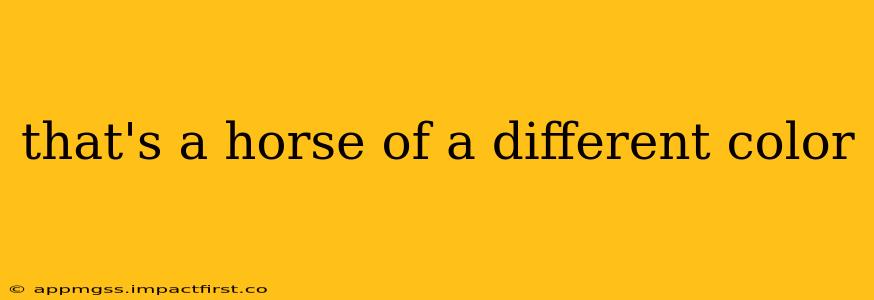That's a Horse of a Different Color: Understanding the Idiom
The phrase "that's a horse of a different color" is a common idiom used to express that a situation or topic is entirely different from what was previously discussed or assumed. It implies a significant change in circumstances or a completely new perspective. While seemingly straightforward, understanding its origins and nuances adds depth to its meaning and effective usage.
This idiom isn't about literal horses; it's about the subtle shift in perspective it conveys. Instead of directly stating a disagreement or difference, it uses a figurative expression to highlight the stark contrast. This indirect approach can often be more diplomatic or even humorous depending on the context.
What Does "That's a Horse of a Different Color" Really Mean?
At its core, the idiom signifies a complete departure from the initial subject. It signals that the previous assumptions or plans are no longer applicable and a fresh approach is needed. Consider these examples:
-
Scenario 1: "I was planning on taking the train to the city." "That's a horse of a different color. The train's on strike!" The strike introduces a completely unexpected and significant change to the travel plans.
-
Scenario 2: "I thought we were discussing the budget for marketing." "That's a horse of a different color. We need to first address the recent product recall." The product recall is a higher priority issue, entirely changing the focus of the conversation.
The phrase implies not just a small difference, but a fundamental shift requiring a reassessment of the situation.
Where Did This Idiom Originate?
Pinpointing the precise origin of "that's a horse of a different color" is challenging. Its roots are believed to lie in Shakespearean times, with some suggesting a connection to the imagery of horses of varying breeds or colors representing different qualities or types. However, there's no definitive historical record directly attributing the phrase to a specific author or period. Its widespread usage suggests it evolved organically within the English language, becoming established through colloquial use over time.
Is There a Difference Between "That's a Horse of a Different Color" and Similar Phrases?
While other phrases express similar ideas – such as "that's another story" or "that's a different kettle of fish" – "that's a horse of a different color" carries a unique connotation. It often implies a more significant and unexpected change, a complete shift in the landscape rather than a minor adjustment. It emphasizes the surprising and contrasting nature of the new information.
How Can I Use "That's a Horse of a Different Color" Effectively?
Using this idiom appropriately involves understanding its context. It’s best suited for situations where a significant and unexpected divergence from the previous topic occurs. Overuse can make it sound cliché, so use it sparingly and strategically to highlight the true contrast in situations. Its effectiveness lies in its unexpected and slightly whimsical nature, adding a touch of color to serious conversations while still conveying a critical point.
By understanding the nuance and history of this colorful idiom, you can confidently incorporate it into your vocabulary and communication, adding depth and expressiveness to your conversations.
